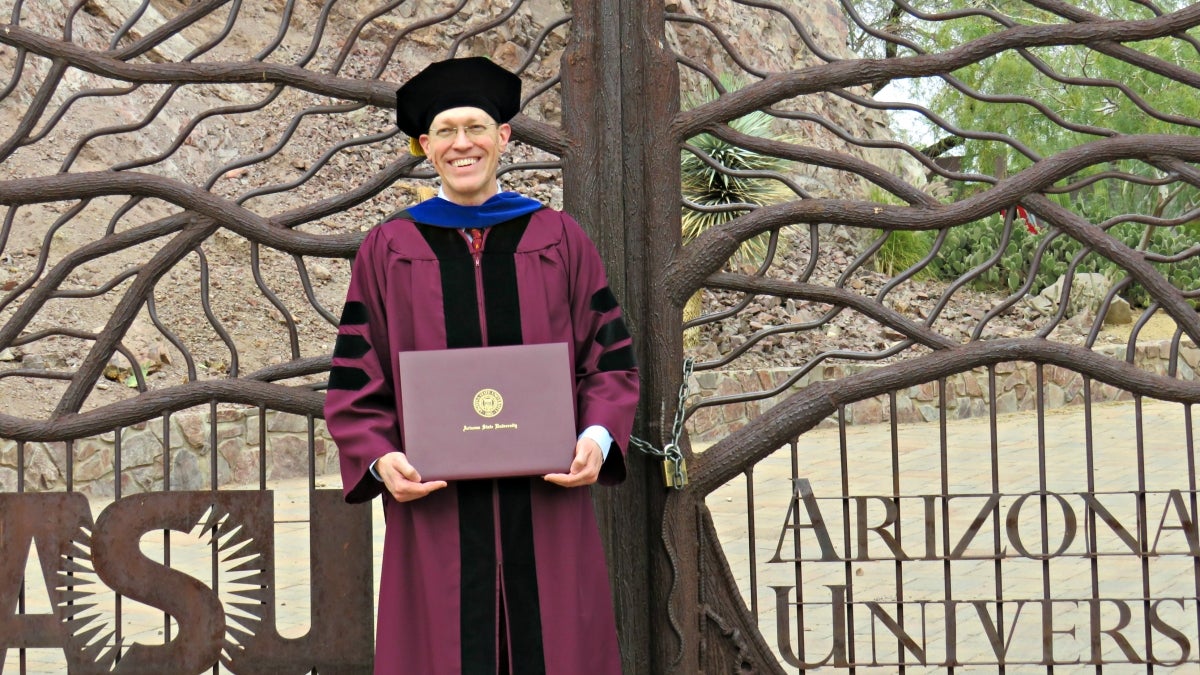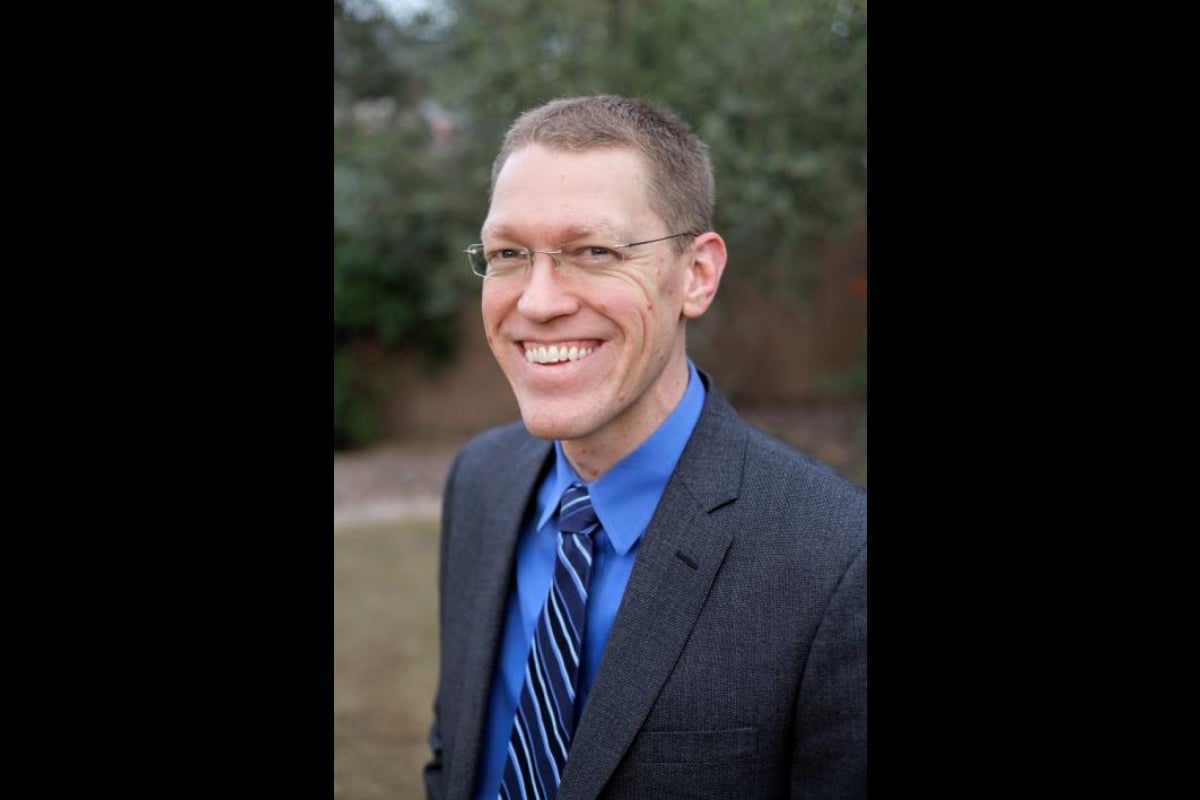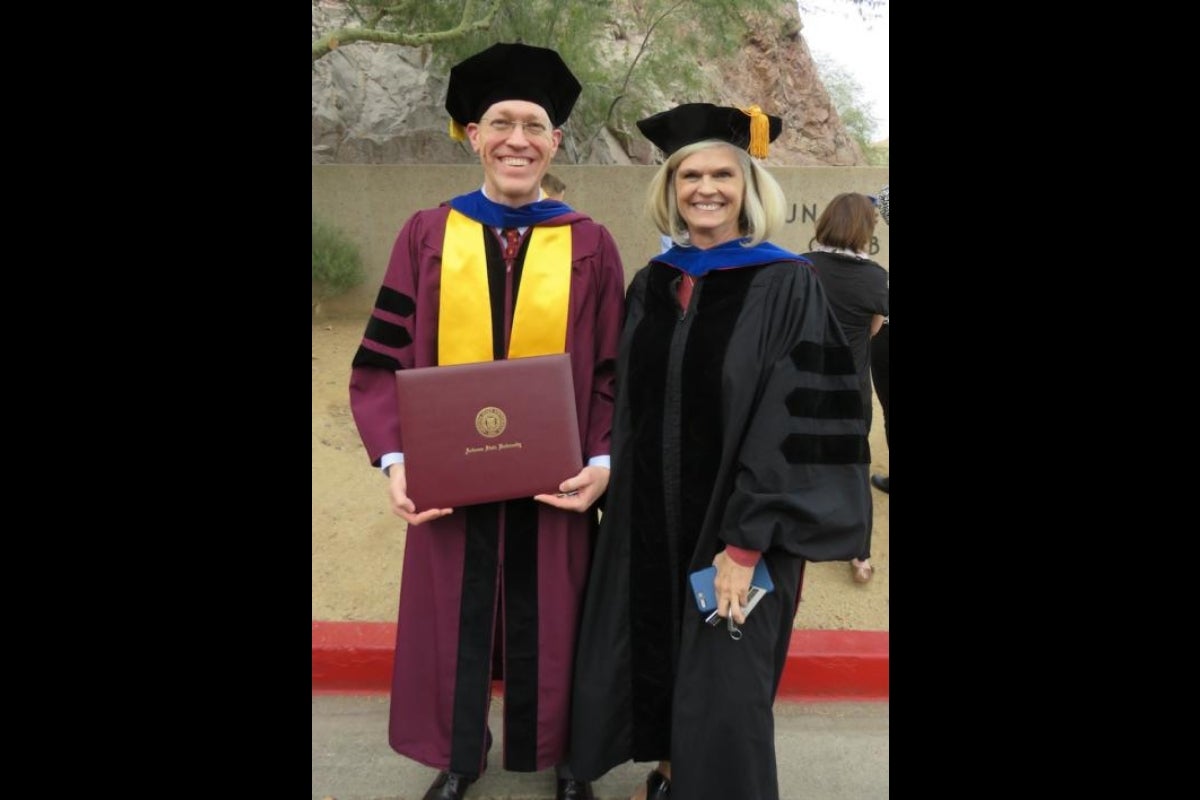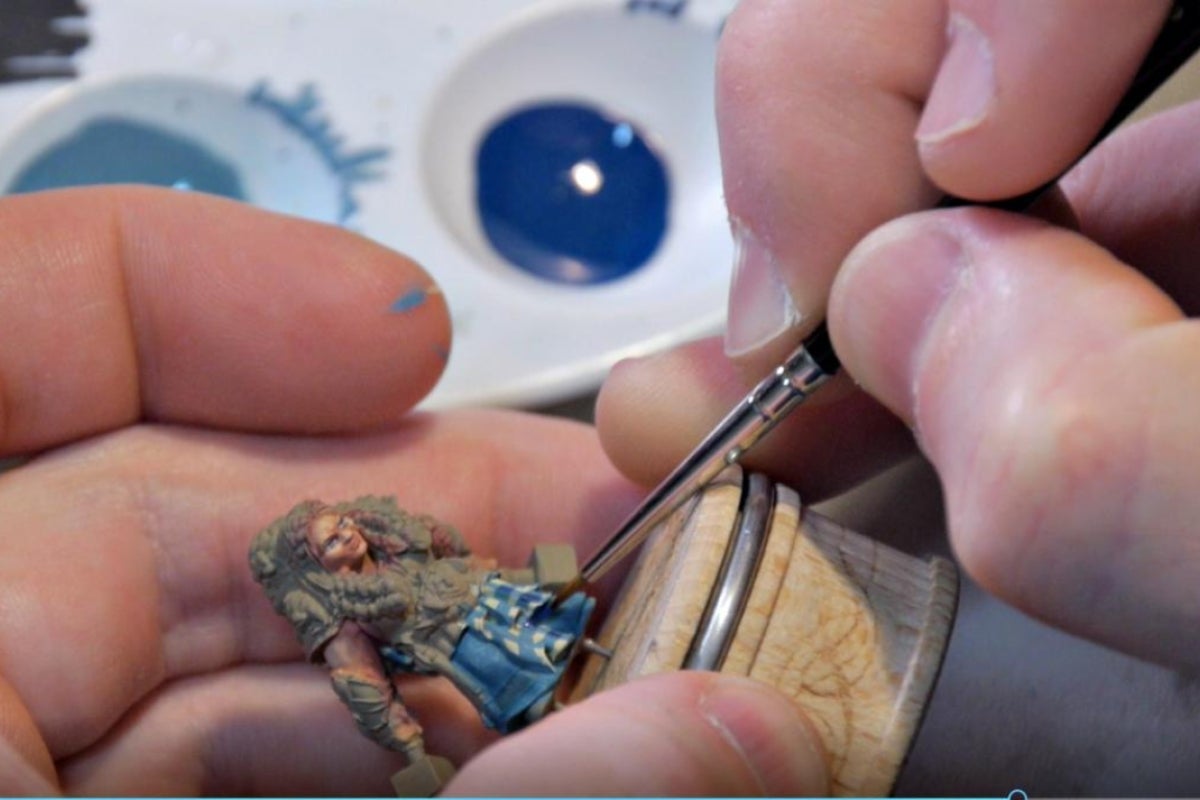Editor’s note: This is part of a series of profiles for fall 2018 commencement. Read about more graduates.
As a student at North Canyon High School in Phoenix, Alan O’Bryan worked part time as a math tutor as soon as he was old enough to drive. That experience, along with the realization of how impactful some of his teachers had been in his life, led him to want to be an educator. His plan when he initially entered Arizona State University was to get a bachelor’s degree in mathematics and get certified to become a high school teacher. But things did not go exactly according to plan.
Although he was always "good" at math, by his second year of college O’Bryan became increasingly uninterested in the focus and content of the math classes he was taking.
“I couldn’t see the big picture. I didn’t really understand what they were supposed to be building towards and I was finding less satisfaction in the time I spent studying,” O’Bryan explained.
“At the same time, I was taking a variety of upper division history classes for my own personal interest, and these experiences were very different. In these advanced history courses, everything was about the ‘big picture’. Facts, dates, names — they were only important with respect to the larger course of human events.”
O’Bryan made the decision that if he was going to be an educator, he wanted to teach a subject he was passionate about. During his sophomore year, he changed his major to secondary education with an emphasis on history.
While attending college, he worked as a math tutor at the Learning Resource Center and as part of the Freshman Year Experience, so he never totally left math.
After his student teaching, O’Bryan ended up getting certified to teach both history and mathematics. But math teaching jobs were far more plentiful than history teaching jobs, so his first job teaching was in secondary mathematics.
He enjoyed teaching, but the real “aha” moment came during his third year in the classroom. ASU professors Marilyn Carlson and Pat Thompson had a grant to support changes in teaching secondary mathematics, and O’Bryan was part of a cohort of teachers they recruited to work with them. He began by taking a graduate mathematics education course with them.
That opportunity changed his life.
“For the first time I was part of a math class that felt like everything I loved about studying history. The focus was always on a bigger picture — important ideas that transcended specific topics and that served as the lens for reasoning about particular problems. I learned more in that one class than I could possibly describe,” said O’Bryan.
“It changed my entire perspective on what it meant to be a teacher in general — to think about my teaching from the perspective of a student in my class, what it meant to teach mathematics, and the power and importance of focusing on coherency within a course.”
In his own classroom, O’Bryan began feeling empowered and excited to throw out his textbook lessons and redesign his courses with a persistent focus on big ideas and how each lesson could be framed as a reflection of those big ideas and not just as a string of isolated topics. The more he worked with Carlson and Thompson, the more he wanted to learn, and eventually he started taking one upper level or graduate math or math education class per semester at ASU while working.
“What was interesting is that my perspective on math had changed so drastically that the courses that once left me unengaged and uninterested now felt different because I was different,” said O’Bryan.
He eventually completed everything needed as prerequisites to be accepted in the Mathematics Education PhD program, and joined Carlson’s Pathways and Pathways TUME grant projects full time while taking one class per semester toward his PhD.
“This was a fantastic opportunity for me since, in addition to my coursework, I was able to use my past experiences and continue to push my own learning in ‘real’ settings — writing and studying curricular interventions, planning, delivering, and reflecting on professional development training programs for in-service middle and high school teachers, graduate TAs and university instructors, and presenting our findings and our work at conferences across the country,” explained O’Bryan.
Carlson mentored O’Bryan during graduate school.
“Alan has been more like a colleague than a PhD student,” she said. “He is an independent thinker and has the highest integrity in the quality of his work and written products. He successfully synthesized some of the most challenging and useful research related to learning and understanding the idea of exponential growth. His expertise in leveraging learning theory of specific mathematics topics when designing instructional materials surpasses that of most scholars in our field.
“Alan is perhaps the most persistent and hard working student I’ve had the pleasure to mentor, always holding himself to the highest standards in his teaching and professional development, in addition to his research. Central to everything Alan does is his desire to learn more so that he can be more and more effective in supporting students’ mathematical learning and development, and teachers' ability to provide more meaningful and engaging mathematics instruction to students.”
In December, O’Bryan received his doctoral degree in mathematics education from the School of Mathematical and Statistical Sciences. He currently works as a senior research analyst in the school, working on the Pathways TUME grant project. This week he took some time to answer a few questions and share more about his experience at ASU.
Question: Why did you choose ASU for your graduate degree?
Answer: I chose ASU primarily because I was already working at the university and with faculty in the department on different grant projects, so it was convenient for me. However, ASU would have been a prime destination for me if I wasn’t already here since the mathematics education faculty and graduate program have a lot to offer prospective graduate students. Studying mathematics education at ASU means getting to work with some of the top researchers in the field and receiving excellent mentoring. There are opportunities for even first-year graduate students to travel to conferences, present research findings, and become involved in large research projects.
Q: What was your dissertation topic?
A: I examined the meanings students have for exponential growth, percentage comparisons and percent change upon entering a university precalculus course, how those meanings changed, or did not change, as a result of completing the online lessons I designed to support particular conceptual understandings, and how students interacted with features of the lessons that either supported or failed to support their learning.
Q: Why did you choose this topic to research?
A: There are two aspects to my research in this area. The first is the particular content focus I chose and the other is student learning within the online environment.
For the content, I noticed that many students had very vacuous meanings for exponential functions, percentage comparisons and percent change entering university college algebra and precalculus courses and that this interfered with students productively using and interpreting exponential models. In addition, I saw a different approach than the typical “repeated multiplication” idea as potentially useful for teaching these ideas in ways that connect their meanings to other ideas throughout a precalculus course to improve coherency in the class from the students’ perspective.
With respect to the setting, most current work relative to online learning treats the mathematical content and presentation methods as unproblematic. Researchers vary the setting alone, but not the approach to the content or the teaching methods. Their work reveals important insights about impacts of shifting instruction out of the traditional classroom environment. But we are currently missing a cognitive perspective to studying student learning in the online environment that includes a systematic and in-depth examination of the meanings students construct as a result of online instruction.
As of 2016, almost 30 percent of students enrolled in postsecondary coursework took at least one distance learning course — most commonly in the form of an online course — and nearly half of those students were enrolled exclusively in distance learning courses. Since many university leaders see increasing online enrollment as key to their growth plans, and since many students targeted for expansion of online learning opportunities include populations of students that are currently excluded from higher education for a variety of reasons such as family, work, location, etc., it is absolutely critical that we understand how to design and deliver the highest quality online instruction to support these students in learning mathematical ideas that will best serve them in their lives, careers and future STEM courses.
Q: Why is math education a great major to pursue?
A: While people have been teaching math for thousands of years, mathematics education as a formal discipline is still relatively young, only several decades old. There are many, many open questions and various theoretical perspectives for conducting research on student learning. It’s an exciting, emerging field with opportunities to contribute to theory and practice that directly impacts students. Knowing that the work I do contributes to improving educational opportunities and the quality of students’ learning is very rewarding.
Q: What’s the best piece of advice you’d give to those still in graduate school?
A: The best advice is to try to maintain as much balance in your life as you can. Graduate school will keep you busy for sure, and there will be times that your coursework must absorb your entire attention and energy. But burnout is a very real and damaging thing and can sneak up on you. Make sure to carve out time to recharge and rest, to pursue a hobby, or spend time with friends and family. Graduate school is a marathon and you need to take care of yourself along the way.
Q: What was your favorite spot on campus, whether for studying, meeting friends or just thinking about life?
A: I have always loved the art museum and the music buildings on campus. I always found it really neat to be able to take a few minutes out of a busy day to visit the museum for some quiet reflection. I also liked to study in the music building and music library. The building itself is beautiful, and as an undergraduate I would often study in the music library while listening to random albums I would pull off the shelf or do homework while listening to talented musicians practice their compositions throughout the building.
Q: What do you think is misunderstood about math by the general public?
A: Through no fault of their own, many people dislike mathematics or, even if they like it, tend to think that math is all black and white — that it’s a discipline focused on finding correct answers to given problem sets. Unfortunately, most people have never experienced mathematics as a creative endeavor involving exploration, conjecture, argument and reflection. Mathematicians don’t spend their time solving problems with obvious solution methods and answers that can be found in the back of a textbook and no industries with careers that leverage mathematics hire people with only that skill. In general, I think that most people’s experiences in grade school mathematics courses have left them with the wrong impression of what it means to really study the subject, and we often miss opportunities to support students in developing more general reasoning skills that will serve them well regardless of what career or discipline they pursue.
Q: When not studying, what do you like to do for fun in your spare time?
A: I love to read — mostly history or books about psychology, science, astronomy or similar topics written in a more conversational tone rather than scholarly journal articles. I also enjoy indoor rock climbing to get the blood pumping and get away from my desk. It’s both physically and mentally challenging, which helps keep me motivated to exercise. However, my real hobby passion is painting model miniatures, which is something I’ve been doing for about 20 years now and for which I’ve received many awards.
There are many aspects of the hobby I really enjoy. It’s challenging and rewarding while providing an artistic outlet, and there are always new techniques to learn to keep it fresh and exciting. But I also find painting extremely relaxing. Painting is basically like meditation for me. I’m able to shut out distractions and just lose myself in what I’m doing. It’s the best activity I’ve found for recharging my mental energy.
I am known within the hobby community as “Gorilla with a Brush”, a name I chose to evoke images of Koko the gorilla and because I try to use my hobby time and my status in the community to raise money to support animal charities. People can find me and examples of my work by searching for that name on the web and various social media platforms.
I was always interested in science fiction and fantasy games, books and art growing up, and while I dabbled a bit in model kits, painting and drawing as an adolescent, in 1998 I started in on the hobby more seriously as something to do to fill my free time that was more rewarding than playing video games or other distractions. Within a few years I was traveling and entering my work in national competitions. These days I don’t really participate in the competitive side of the hobby and spend more time just painting for myself, working on commission pieces, supporting others in the hobby looking to improve their skills and raising money for charity.
Q: If someone gave you $40 million to solve one problem on our planet, what would you tackle?
A: I think I would continue trying to tackle the problems I am now. One thing that is very clear from reading math education literature, from personal experience and from discussions with researchers across the country, is that mathematics is a gatekeeper for many high-paying careers and too often prevents students from achieving their dreams. We have a system where the groups of students passing college calculus at high rates are those students who already took calculus in high school, where students are testing into remedial math courses at institutions that might not offer credit-bearing math courses until Calc I (while all courses in their majors require it as a prerequisite), etc., and students from several demographic groups are disproportionately impacted in negative ways. We need to find ways to improve the quality of mathematics instruction at all levels and for all students, to find creative solutions to promoting success and addressing gaps in background learning, and facilitating connections between mathematics and other disciplines so that mathematics is the vehicle for helping break cycles of poverty and empowering students instead of being a barrier to their progress.
More Science and technology

ASU professor honored with prestigious award for being a cybersecurity trailblazer
At first, he thought it was a drill.On Sept. 11, 2001, Gail-Joon Ahn sat in a conference room in Fort Meade, Maryland.…

Training stellar students to secure semiconductors
In the wetlands of King’s Bay, Georgia, the sail of a nuclear-powered Trident II Submarine laden with sophisticated computer…

ASU startup Crystal Sonic wins Natcast pitch competition
Crystal Sonic, an Arizona State University startup, won first place and $25,000 at the 2024 Natcast Startup Pitch Competition at…




